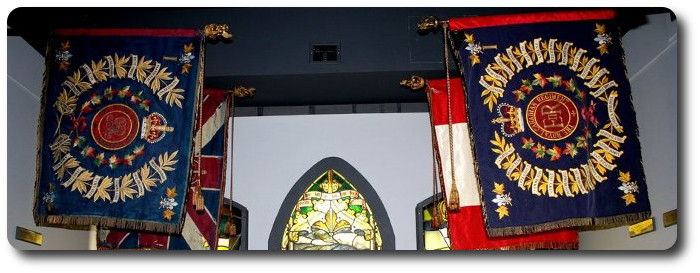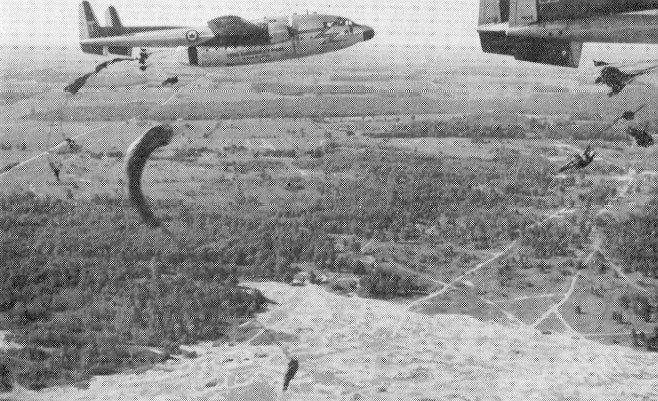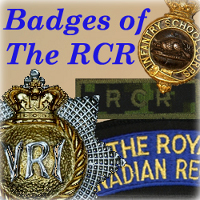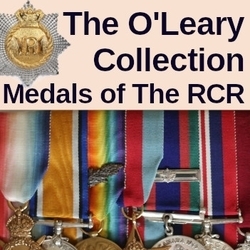
Researching The Royal Canadian Regiment
The End of an Era
WO D.J. Lacroix
The Connecting File, 1968
At 7.30 A.M. on Wednesday September 25th 1968, a group of 1 RCR parachutists jumped from a Buffalo aircraft above the CFB Borden training area. With this jump, conducted with the aid of the famous 429 Squadron from St. Hubert, an era in the life of The Regiment came to an end.
It was twenty years ago that the decision was made to train the three infantry battalions as parachutists. The PPCLI were the first to take the para course at Rivers. Then it was our turn.
Things got under way rather suddenly when, one morning in Brockville, there appeared two soldiers running around our quiet little camp. "Who are they?" we asked. They wore red berets and high brown boots and a strange (to us recruits) hat badge. The answer was not long in coming. These were para instructors from Rivers who would organize and set the groundwork for our airportability and pre-para training. We couldn't get over how they doubled around camp whenever they went anywhere. Like recruits in any army, we were subjected to a good variety of stories from the older soldiers in the canteen. We were told things like, "These guys are the toughest there are," and, "You better do what you're told, these para instructors don't fool around." Needless to say, we did and they didn't.
Shortly after this the "serials" were formed and the first groups started their pre-para training. In the first group to go to Rivers was our new CO, Lieutenant-Colonel P R Bingham. By this time orders were issued that any personnel moving around the camp would do so on the double. It cut the pedestrian traffic down a little but it was a long day for the company runner (a duty of which I had an ample share).
Airportability consisted of manoeuvring jeeps and 3/4's into a mock-up of the C 47 Dakota. We could tell at a glance that it was quite impossible to fit these vehicles through the door. Imagine our surprise wben the instructors, our own NCOs, demonstrated how it was done? Clever fellows, these NCOs! We squeezed each vehicle into and out of the mock-up a thousand times in the morning and a thousand times in the afternoon, it seemed. (Who ever would have thought that some day they would just drive vehicles onto a plane!)
The pre-para training, again conducted by our own NCOs, consisted of push-ups, running, sit-ups, running, rope climbing (up and down, no sliding allowed), running, with a bit more running thrown in for variety. I always got the sergeant who couldn't make up his mind how or where he wanted us—"Sit down!"—"Stand up!"—"Over here!"—"Over there!"—and on and on completely ignoring our aches and pains and coffee breaks. Later when we got more of this in Rivers we had reason to thank the NCOs for this preparation.
And so each serial in turn took their turn at this and proceeded to Rivers. Pretty soon the unit was all qualified and everyone was wearing red berets. Now we had exercise jumps in Petawawa and Fort Churchill. Later the 2nd Battalion took up the airborne role and all became active jumpers.

Looking back now over a period of twenty years there are incidents that we will never forget.
We remember the briefing Colonel Bingham gave us once just prior to a march-past for a visiting high-ranking officer from Ottawa. "Look him in the eye," said the CO, "in the eye. Remember, you're airborne and he's not!" (By this time he was calling us his "Tigers" and a difficult job was a "Piece of cake").
We remember the jumps each week at the Fire-Power demonstrations in Petawawa. It always ended with an attack on a small shack. We attacked it, we bayonetted it, we kicked it down, threw grenades at it, and then just to make doubly sure, we blew it up. No matter, the following week when we hit the ground, there it was again!
We remember the feeling of excitement and close comradeship that always accompanied each jump and the stories afterwards in the canteen. The shout, "Fifteen seconds!" was enough to wake butterflies in even the most dedicated stomachs. But afterwards - Ah then it was a different story! Then we were calm and cool and we carried our chests a little further out than usual. In the plane we wondered what on earth would possess men to make them do such a thing, almost defying the law of gravity. After the jump, we couldn't imagine a life without this experience every so often.
We remember with sorrow the deaths of Sergeant Bruce Chiswell, Warrant Officer Mike MacDonnell and Master Warrant Officer Reg Riddell on a jump in Petawawa in May 1968.
No doubt there are other incidents that stand out in both battalions. No doubt also that each jumper has his own story to tell.
So, another significant chapter is written in the history of The Regiment and it is with a sense of achievement that all members can look back on our activities.
Many of our jumpers have gone to the Canadian Airborne Regiment and our thoughts will be with them on their jumps. We can only wish this fine new unit the best of luck and we are sure that they will continue, as we in The Regiment, to "Serve with Pride".


